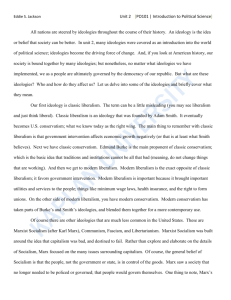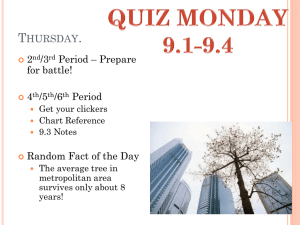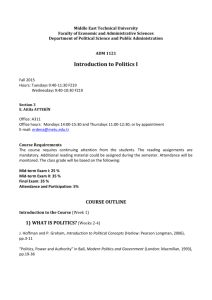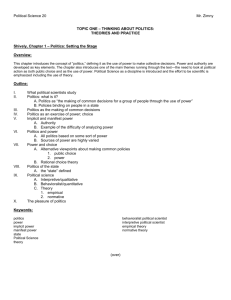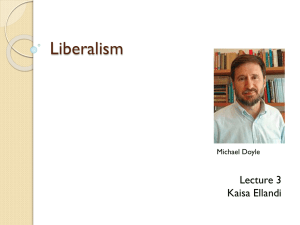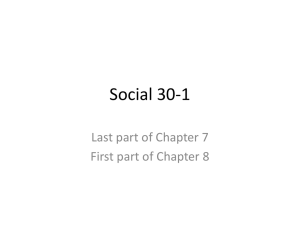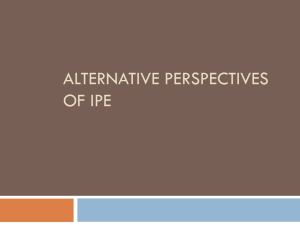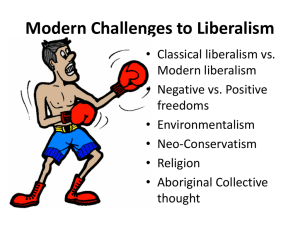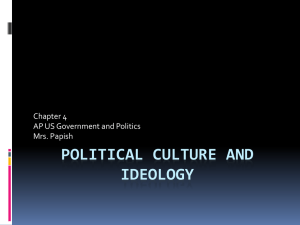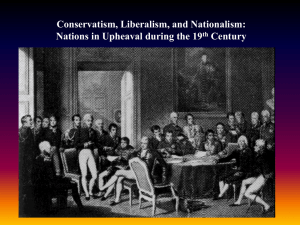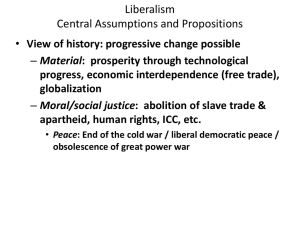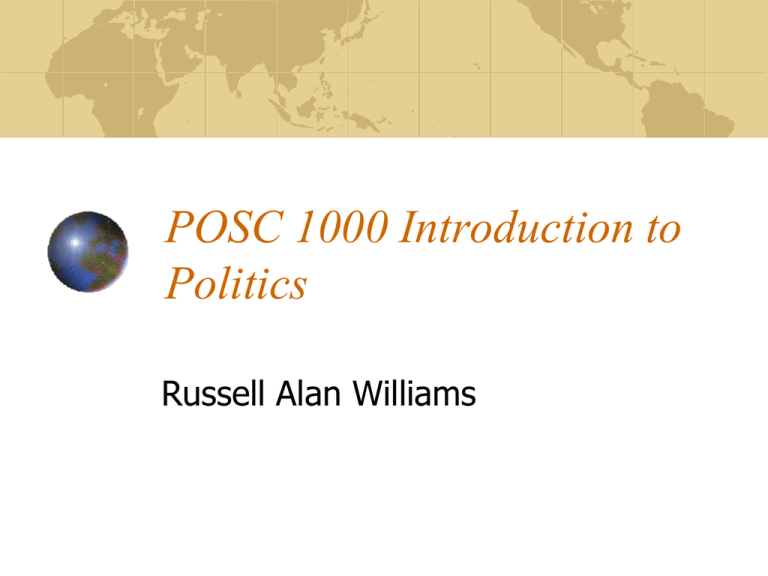
POSC 1000 Introduction to
Politics
Russell Alan Williams
Unit Three:
Politics and Ideology
Required Reading: Wood and MacLean, Chap 3.
Unit Objectives:
Explore political philosophy and key ideologies
Outline:
1.
2.
3.
4.
5.
6.
Introduction – Political Phillosophy
Liberalism
Conservatism
Socialism
Nationalism & Fascism
Newer Ideologies
1) Introduction – Theory (?):
The oldest tradition of writing and thinking about
politics focuses on the content of political ideas
“Political Philosophy”: Study of questions
about existence, knowledge, ethics, justice and
morality based on logical reasoning rather than
empirical method
= Political theory, or ideas about how we are, or
should, be governed
= Ideologies that drive political debate
A brief history of political philosophy . . . .
Plato (427-347) “The Republic”
Goal of politics in Greek democracies was order
The Republic needed to ensure everyone was in their
proper place, the work of a “benevolent” power
“Utopian”: Idealized system or
society
Niccolo Machiavelli Plato (14691527) “The Prince”
Response to the problems of order – a
guidebook for how to succeed in
governing a state . . . .
Key idea: “Political Realism”:
Approach to politics that emphasizes the
importance of power and interests over
ideology or morals and ethics
A wise (and virtuous?) prince does what
is necessary to secure the state – power
is its own virtue
Many critics – much of the subsequent
tradition seek universal standards of
justice and ethics . . . E.g. “liberalism”
Most important contemporary movement in political
philosophy?
“Social Constructivism”: Sociological and political theory
that explains political interactions in terms of the ideas
imprinted on individuals by society
There are no universal norms, as “identities” vary depending on
culture, gender etc.
Critical of the universalism of “Liberalism”
• E.g. Judith Butler (1956 - )
How do we judge what is “right” or “good” for society, or
the individual?
2) Political Ideologies - Liberalism
“Ideology”: System of ideas that form the basis of a
political or economic system and provide ideas about the
goals of society and governments
• Each is descriptive – how the world works
• Each is prescriptive – how the world should be
Most modern ideologies derive from the Enlightenment:
18th century intellectual movement
• Human reason could be more effectively used to
understand an improve the world
• Challenged traditional role of Church and faith?
Organizing ideologies:
a) “Left vs. Right continuum” - Based on attitudes towards
free market capitalism & traditional values
“Left”: Support greater social and economic equality, oppose
traditional religious values (?)
“Right”: Support traditional values, oppose state
“innovations” to promote equality
Popular typology, but problematic
• E.g. “Totalitarianism”: States that attempt to control all aspects
of life
Liberal thought:
“Liberalism”: A view of politics that favors liberty, free
trade, and moderate social and political change.
Focus on the rights of the individual in relation to the state
• “Self Determination”: Ability to act on free choices without
external coercion
• Requires a system of consent for governments – E.g. “General
Will”: Will of the whole community.
• Requires a system for protecting the rights of individuals against
the “General Will” – e.g. “Toleration”: Acceptance or protection
of individuals, groups and types of behavior that may be
disapproved of by the majority in society
“Liberal Democracy”: Political system based on freedom.
Requires that governments have the assent of all citizens through
representative electoral institutions and the rule of law which limits
the power of governments.
Types of Liberalism:
Classical Liberalism: Committed to limited government
and the free market
“negative liberty”
E.g. John Locke (1632-1704)
Economic liberalism - Adam Smith
• “Invisible Hand””: Markets are better than government in
allocating resources – let individuals and business freely
interact
Reform Liberalism: Support for individual freedom etc.,
but belief that some state involvement necessary to
remove obstacles to individual development.
Combine equal rights with equal opportunity . . . And
“positive liberty”
• E.g. State funding for education – create
opportunity for all
Closely associated with Keynesianism and social
welfare programs
3) Conservatism:
Critical response to enlightenment liberalism
Emphasizes value of order, stability and
tradition.
Source: Edmund Burke
(1729-1797)
Ideas of conservatism are complex and contradictory(?)
Problem:
Humans are weak
= need for authority to check irresponsible desires
= ineffective government “innovations” in society
Paternalism: Elites have a responsibility to look after
society not pursue their own interests
Support institutions and ideas that promote stability and social
order
• E.g. Marriage, family and religion
Skepticism about experimentation:
Traditional institutions good even if reason suggests otherwise
• E.g. The British Monarchy
Types of conservatism?
Economic conservatives: Shared values with Classical
Liberals
E.g. “Neo-liberalism”: Rejection of reform liberalism – return to
limited state interference in economy
• Often associated with “Neo-conservatism”
New Right: Critical reaction to rise of reform liberalism
and new ideologies like feminism
•
•
Combine neo-liberalism with conservative social values
Some times internally at odds . . . .
Social (or traditional) Conservatives – Traditional values
more important than economic conservatism
E.g. Paternalism and “Red Torys”
Reactionary Conservatives: Those who favor a
radical return to traditional (?) values
Not really an ideology, but . . .
4) Socialism:
Major source of 19th and 20th century opposition to liberalism .
...
Egalitarian focus on human society – humans are entitled to
equal outcomes
“Capitalism” undermines social nature of human communities
Critical response to liberalism and free markets – benefits the
“Bourgeois” at the expense of others
Key source: Karl Marx (1818-1883)
Focus:
Economic equality – “equality of condition”
rather than equal rights
•
Requires “class conflict”
– State intervention
– Redistribution
Social ownership of “means of production”
•
E.g. “Communism”: Political theory that highlights
class struggle to form a system where all property is
publically owned and citizens are equally compensated
5) Nationalism and Fascism:
“Nationalism” = the most important ideology of the 20th
century
Based on belief that “peoples” have shared language,
culture, history that differentiates them from other
nationalities
Justification for independence and statehood
Justification for imperialism and international conflict
Conflict with “Liberalism”?
Created through popular culture and “Propaganda”:
Spreading information (true or not) for the purpose of
aiding a cause or making people react in a certain way
“Fascism/Fascist”: Aggressive nationalism combined
with an acceptance of inequality as natural
Liberalism and socialism are “utopian” failures.
6) Newer Ideologies:
Status as ideologies more uncertain – have only begun to influence
the way people think about politics . . .
i) “Feminism”: Perspective that seeks equality and independence of
women
Focused on “patriarchy”: System in which power is in the hands
of men and in which women’s lives are controlled by men.
Types:
“Liberal Feminism”: Focuses on
equal legal and political rights
End legal patriarchy
• E.g. the struggle for “Suffrage”
End legal structures based on sloppy
thinking about gender, sex and
sexuality
• E.g. the modern “Lesbian, gay, bisexual,
and Transgender Movement (LGBT)”:
Seeks to reform legal structures to reflect
diversity in sexual and gender identities
“Radical Feminism”: Society based fundamentally on
oppression of women.
Patriarchy is not just legal, it is also economic
and personal
Results in wider critiques of the images of
women in society
– “Objectification” and sexism
Results in wider discussion of the limitations of
liberal rights
ii) “Environmentalism”:
Sees need for humans to change relationship
with nature
Politics and economics must be limited by natural
constraints of ecosystem - traditional ideologies
ignore this
•
“Anthropocentrism” vs. “Ecocentrism”
“Sustainable Development”: Model of
economic Growth that seeks to ensure that the
use of resources today does not destroy the
environment for those in the future
7) For next time:
Unit Four: The Functions of Governments
(January 28 and 30)
Required Reading: MacLean and Wood,
Chapter 4.


